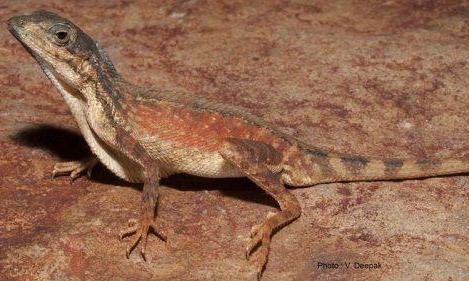A team of researchers from Indian Institute of Science, Bengaluru and Natural History Museum, London discover two endemic species of lizards from the Western Ghats. While one of the species – Sitana gokakensis was found from Belagavi district of Karnataka, the other, Sitana thondalu was found near Nagarjuna Sagar reservoir at the foothills of Nallamala ranges in Andhra Pradesh.
Bengaluru (ISJ) – A team of researchers from Indian Institute of Science, Bengaluru and Natural History Museum, London have discovered two endemic species of Fan-throated lizards from Western Ghats.
While one of the species – Sitana gokakensis was found from Belagavi district of Karnataka, the other, Sitana thondalu was found near Nagarjuna Sagar reservoir at the foothills of Nallamala ranges in Guntur district of Andhra Pradesh.
Fan-throated lizards, as the name suggests, have a fold of loose skin hanging from the throat in males. Also, called dewlap, it is used in communication during the breeding season.
The study, published in the journal Zootaxa, was undertaken in Dr. Praveen Karanth’s lab at the Centre for Ecological Sciences, Indian Institute of Science, and funded by fellowships from Department of Biotechnology and Rufford Small Grants.
The genus Sitana are small, ground-dwelling lizards that form an essential part of the food chain in dry, arid landscapes. “Several birds, mammals and snakes prey on these species, and they feed on small insects,” said V. Deepak from IISc, who is the lead author of the study.
The two species are cryptic, meaning they aren’t easily distinguishable just by their looks. Hence the researchers collected tissue samples from the sites and carried out DNA analysis.
“The lizards were hand-captured, and their tail samples were obtained before releasing them. We initially had only eight males between the two species, but once we realised they were cryptic species, we had to collect at least ten males per species to be able to identify them properly,” recalled Deepak. “Since we sampled during the breeding season, we tried to avoid capturing gravid (carrying eggs) females. Males were identified by the full colouration of the dewlap.”
The researchers found, the two new species are distributed 500 km apart from each other and are endemic to their localities. S. gokakensis is found in the open rocky dry habitat of the Gokak plateau, characterised by thorny and dwarf succulent plants. S.thondalu, on the other hand, was found in the dry, rocky outcrops with sparse vegetation and stunted trees in Macherla and Nagarjuna Sagar in Guntur district.
The researchers also used specimen data for comparison from their previous study of 200 museum specimens of four different species maintained in various zoological institutions in Odisha, Kolkata and Pune. They used differences in their genetic codes and geographical separation to determine their endemicity.
“We had a good amount of molecular data that I collected from across India from 107 locations for an earlier genetic study. Hence, we were able to confidently ascertain that these two were endemic to the described localities. In this study, we also sampled extensively in the areas around and intervening the two species to find out if they were geographically isolated,” explained Deepak.
A phylogenetic tree analysis showed the two species were genetically different. The deeper and farther away the branches of the species are on the tree, the more genetically distinct they are. In this case, they showed deep divergence, to be considered as separate species.


